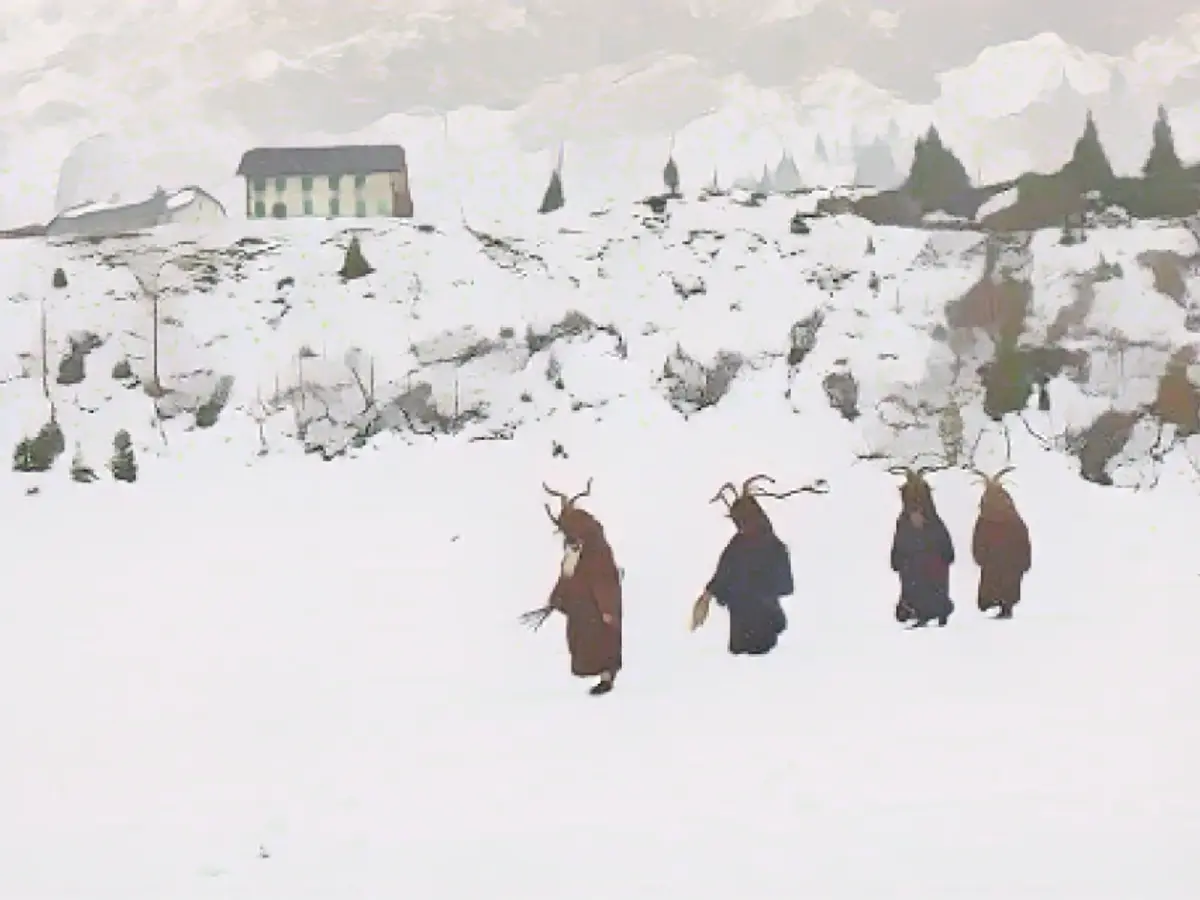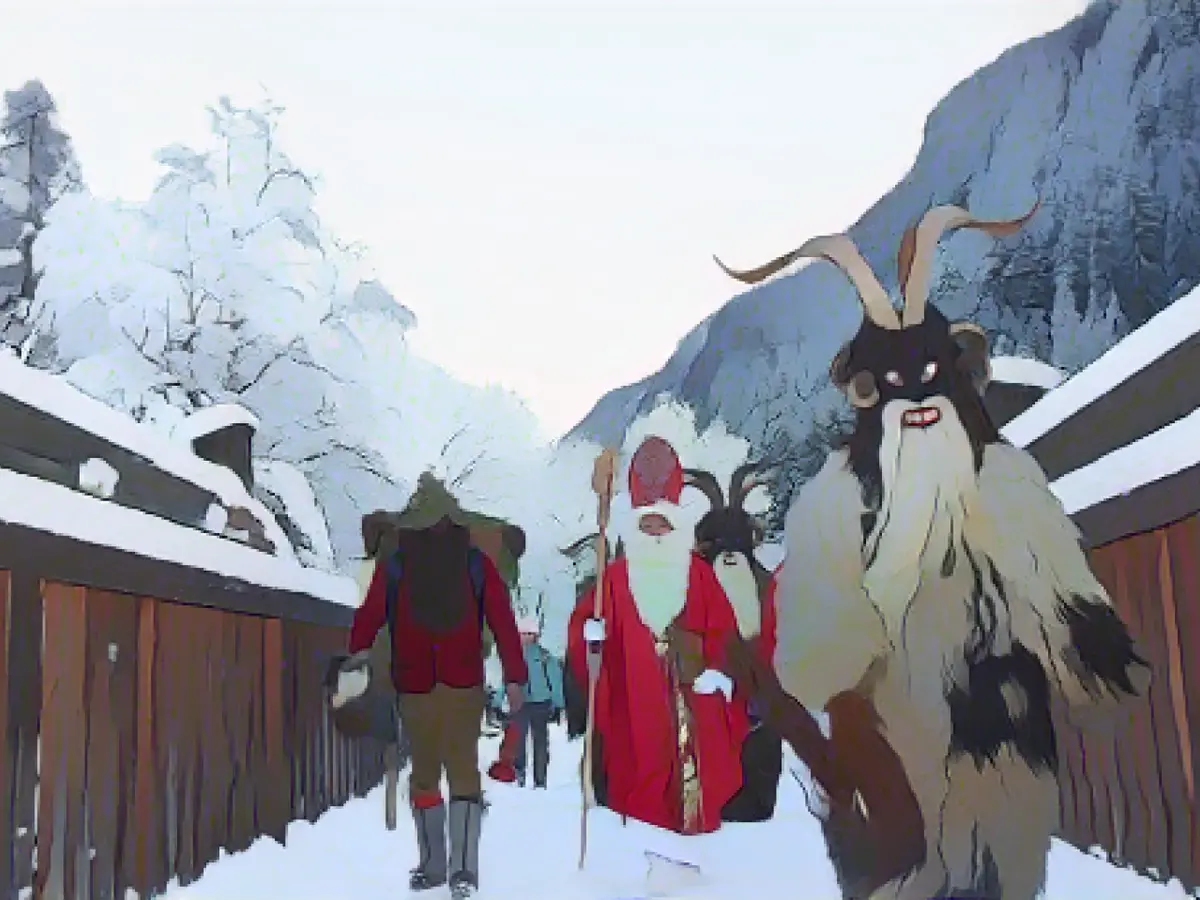Old Advent custom - St. Nicholas and his creepy companion: Why Krampus is still a must today. A declaration of love
It is probably one of the most distant moments in my memory: I was only two years old when an intruder placed little red bags behind the dimly glazed door of the dining room in my parents' house. Somewhere in the distance, a chain rattled. My parents probably didn't want to intimidate me too much as a small child and had therefore kept Santa Claus at a distance. It was only when the man - I later learned that the then primary school teacher in our village had been dressed in the saint's costume - had gone that the door was opened and I pounced on the bags of sweets. I still remember the sticker of a devilish grimace on them, a harbinger of the terrible encounters that were to come in the years that followed.
A frightening thing happened just one year later: This bishop with the sack full of gingerbread and nuts came in person and with him a sinister companion in a carved mask and horns, my various impertinences and transgressions of those months were recited from the golden book and Krampus waved his rod. Today, it would probably be condemned as "black pedagogy" what has been presented and sometimes done to children for ages: gentlemen dressed up as bishops preach sermons on small children, while others in grimacing larvae and terrifying skins growl and shout. However, it doesn't seem to have traumatized me too badly. After all, only a few years later I went from house to house as Nikolo myself, flanked by my friends Esa and Nani as Krampuses.
Who needs archaic customs anymore?
But what is actually happening? Where do these dark traditions come from, which still scare children today, especially in the Alpine region? And do we still need these customs today?

The veneration of St. Nicholas dates back to the 6th century, when the Roman Emperor Justinian ruled. He consecrated a church to the priest in Constantinople, the once Christian metropolis that is now known as Istanbul. The cult of St. Nicholas soon spread via Greece to the Slavic countries, conquered Russia and came to Central Europe via Italy. The young man from near present-day Antalya was ordained as a priest at the age of 19 and is said to have performed all kinds of miracles, at least he was famous for his mercy, although it is not even certain whether the Catholic Church ever canonized him, this star of their religion. The alleged canonization in 1222 at a church council in Oxford is not historically confirmed. His heroic deeds allegedly included saving three young women from prostitution. The girls' impoverished father is said to have lacked the money to marry off his daughters, whereupon the kind man from Myra threw pieces of gold down the chimney of the house, which landed in the girls' socks. We recognize all this in the Santa Claus traditions, and it is quite certain that these are, well, rhymed legends.

There are other stories about how St. Nicholas managed to become the patron saint of children over the centuries. For example, the noble churchman is said to have ransomed youngsters who had been kidnapped as slaves by pirates with his church treasure. The figure is said to have played an educational role as early as the Middle Ages; in 1686, an English doctor reported on his travels to Austria and that children there were given small gifts to put in their shoes in the name of St. Nicholas, and in the 18th century, reports of the parade of the gift-bringing bishop and his Krampus became more frequent. And there are stories of abuse by Krampus, who went around the streets and escalated. However, even back then, none of the large department stores stopped them from selling chocolate figures, masks, souvenirs and "Zwetschkenkrampusse" at a profit.
The tradition was always changing and adapting
When I was just nine years old and put on the Santa hat I had made myself, I was of course unaware of all this. It was only later that I learned that, as with so many old customs, this Christian form of popular piety is mixed with the traditions of pagan ancestors. In Germany, people are particularly familiar with Knecht Ruprecht, who, like the Alpine Krampus, may well have his origins in the dark spirits of the Rauhnächte. There was a certain Frau Perchta, a relative of Frau Holle, also known as the Nordic divine Hulda. According to the mythology of Germanic and Slavic tribes, she was a judge of lazy and industrious people. To this day, this Perchta leads the way in traditional alpine processions with bizarre figures, which is why they are called "Perchtenlauf". All of this is in turn linked to the Rauhnächte, as the twelve nights between Christmas and Epiphany on January 6th are known, when the laws of nature are supposedly suspended and the boundaries to the "other world" of ancestors and spirits are lifted. The term possibly comes from the Middle High German word "rûch", which means "furry", which brings us back to Krampus. You're still coming along, yes?
The further you get into the Alpine region, the more archaic and disturbing these customs become. And of course there are annual calls to put an end to the pagan hustle and bustle because it is no longer in keeping with the times. In many places, however, the Krampus runs are hardly any different from those held around the world for Halloween: Horror costumes, devil masks with electric glowing eyes and fire-spitting devices are donned, frippery and mummery in other words. Last year, I ventured to the most important place for the traditional Krampus custom, Bad Gastein in Salzburg. The most original form of the tradition reigns here, presumably landed from Tyrol when there was a shortage of workers in Salzburg due to the expulsion of the Protestants. Even then, according to the municipal archivist Horst Wierer, the custom is said to have been used for Christian purposes, where there was first talk of "devil's larvae" in 1450, which were used in spiritual games of meaning.
Visiting the guardian of the old spirit
Rudi Mitterhofer lives in the Gateinertal valley and is a kind of guardian of the Lord's Seal of Tradition who carves the most beautiful Krampus larvae (from "larva", Latin for ghost). He gave me an insight into his larva carving art and the inner workings of the "Passen", as the small groups of almost exclusively male youths are called. This has less of a male-bonding aspect than a physical one. The gigantic wooden masks and heavy skins can only be shouldered by very athletic boys for nights on end. As a 50-year-old who is not particularly fit, I was ready to go after a quarter of an hour when I was asked to try it out.

And yet it was obvious that even the most terrifying devil costumes and demon heads of modern times must look ridiculous compared to the more primitive traditional wood carvings. Perhaps, I thought to myself, because it is not reminiscent of Hollywood horror movies, but of what indigenous groups around the world have been making in a similar way since time immemorial. Whether the famous Benin bronzes of Africa, the grimacing Polynesian Tiki masks or some of the faces on Native American totem poles: the old Krampus larvae are not far removed from this. Fear feeds on the knowledge that our ancestors have already run away from it, and remnants of fear may be stored in the gene pool, who knows!
Now I don't want to hide the fact that the Krampus runs claim victims every year. In 2020, the town council of Bad Tölz discussed ending the tradition when a woman was beaten black and blue. In Berchtesgaden, there was a court case at the beginning of this year after two men in Krampus costumes pushed a woman to the ground and rubbed her with snow. One of them then allegedly stuck his tongue in the young woman's mouth. Krampus costumes that were too wild also injured a nine-year-old and broke his metatarsal bone; earlier in Braunau am Inn, the barrier fence had fallen over during the chase. Anyone who has ever been in one of these costumes knows how difficult it is to get your bearings and how limited the scope of action is. Nevertheless, a ban would be wrong, completely wrong.
Krampus and carnival, the high festival of the dissolution of boundaries
The eminent philosopher Peter Sloterdijk once praised carnival, which can be seen as a related tradition, as one of the "most important inventions of civilization". Like the carnival parades, Krampus parades and Perchten runs are inherently anarchic. The state of exception is the meaning of these traditions, the ecstatic is its important element. As with more recent archaic-anarchist traditions, such as the May Day riots or a pogo dance at rock concerts, things have to be rough and wild, but the penal code remains in force. Rebelliousness is limited in time and only works as long as order is maintained, which may only be violated in an idealistic sense.
Especially today, when the rules and regulations are getting out of hand, the law books are swelling and a politically correct moral doctrine is leading to ever new social constraints, the wild and freedom-loving in us needs its outlet. But even without a Christian framework, the principle remains the same: those who celebrate should also fast. And those who take their devils for a walk must also catch them again.
Read also:
- Sky documentary: "23 - The mysterious death of a hacker"
- TV tips on Tuesday
- The Christmas streaming offer at Sky
- TV tips on Saturday
In the Alpine region, the tradition of Krampus, the sinister companion of St. Nicholas, continues to terrify children during the holiday season. This character, often depicted with a carved mask and horns, would warn misbehaving toddlers about their transgressions. (Catholic Church, toddlers, Priest, Krampus)
Despite the criticism that such customs may be considered black pedagogy, the author recounts their personal experience participating as a young Nikolo, accompanied by friends as Krampuses. (bishop, gingerbread, nuts, Krampus, rod)
Source: www.stern.de








